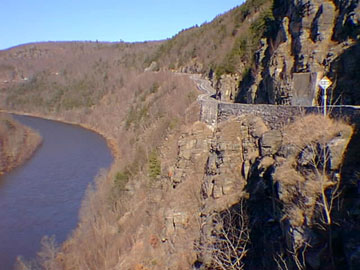38. Port Jervis Gorge
Having traveled as far as High Point, it is well worth the additional drive to perhaps grab a meal in Port Jervis, then stop at the overlooks in Port Jervis Gorge along Pa Route 97 north of town. This winding stretch of highway along the gorge of the Delaware River should be familiar to anyone who spends time watching television; it is the site of numerous car commercials (Figure 82). The gorge is also a popular birding stop because bald eagles are frequently sited soaring along the cliffs.
 |
| Figure 82. The Delaware River Gorge north of Port Jervis. Late Devonian sedimentary rocks of the Catskill Group are well exposed along sinuous Pa Route 97 (beckoning another car commercial). |
The town of Port Jervis is situated on a great bend on the Delaware River. The river drains southeastward, dividing a the region of nearly flat-lying Late Devonian sedimentary rocks of a great plateau (the Catskills are to the northeast in New York, and the Poconos are to the southwest in Pennsylvania). At Port Jervis, the river bends to the southeast following the Port Jervis Trough, the valley formed along the belt of steeply westward-dipping Early and Middle Devonian strata along the western flank of Kittatinny Mountain.
Traveling north from Port Jervis on Route 97 the road gradually climbs up section through the Middle Devonian Hamilton Group into the Late Devonian strata of the Catskill Group. The strata in the gorge are gently dipping to the northwest. Near the southern entrance of the gorge the dark gray shale and mudstone of the Mahantango Formation yields marine fossils, mostly scarce brachiopod fragments. In the vicinity of the sinuous curves and roadside overlook pull offs, the cliffs consist of lower Late Devonian Catskill Group (or Genesee Group). If time and extreme care are taken, it is possible to find pieces of fossil wood exposed in the cliffs and ledges of the dark sandstone above the road. The fossil wood are fragments that were buried in ancient streams channels; some fragments reach several inches in diameter and several feet in length. The wood is from ancient fern trees which lived on the ancient flood plains or in the Acadian Highlands regions to the east. These fragments of wood are some of the oldest fossil wood found on Earth!
| Return to Valley and Ridge Province Main Page. |